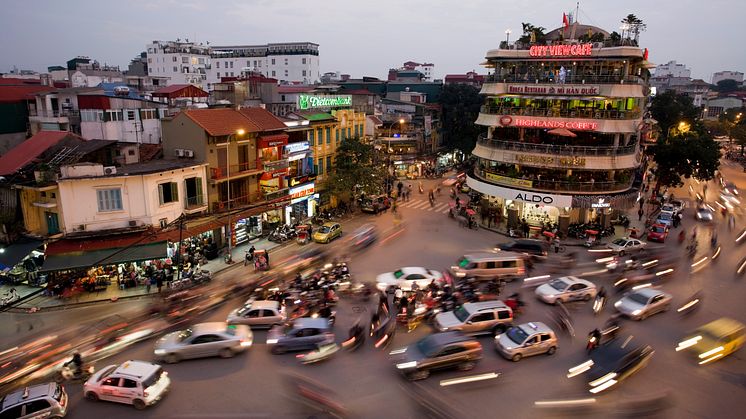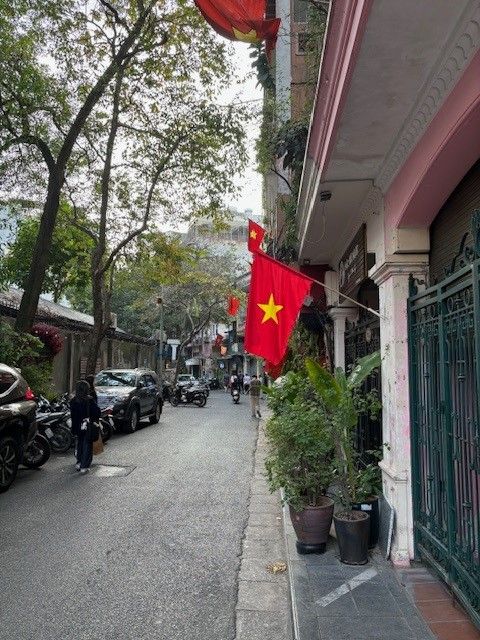
Blog post -
Chaotic, risky and noisy: But is there something we can learn from Vietnam’s city roads?
It was 5pm and the early spring warmth in Hanoi, the Vietnamese capital, elicited a drink stop on a balcony terrace overlooking Hoam Kiem Lake in the heart of the old quarter. Hanoi, like many large Asian cities, can often leave visitors not just mesmerised by its vibrant colours and architecture, but also overwhelmed by the incessant sound of car and moped horns and choking exhaust fumes. Every inch of road space at major junctions seemingly becomes a battleground for hoards of busy locals and wandering tourists.
Even though we wanted to see sunset overlooking Don Ngoc Son, the temple which floats on an island on Hoam Kiem Lake opposite the balcony, our fixation turned to Dong Kinh Nghia Thuc Square to our left which could be lazily described as Hanoi’s version of Piccadilly Circus. Branded shops, western fast-food outlets, lively bars and street eats dominate the pedestrian space though unlike Piccadilly Circus, this square has only a single roundabout and no traffic lights. Indeed, it has very little in the way of anything directing road users, including painted road markings.
Instead, taxis, minibuses, mopeds, pedicabs and pedestrians descend on a junction that at first sight seems like a lawless mess. A closer inspection, however, appeared to demonstrate that the impact of effectively having no rules had a rather surprising impact on the behaviour of road users.
Car and moped horns were simply used as a way of alerting people that the vehicle was there and was coming through and all drivers and riders did this at a glacial pace almost without stopping. Everybody indicated (unlike at UK roundabouts) because where no rules seemed to apply, there was an unwritten code that people must know where you are going so the system can work.
Pedestrians would wait but once they started to cross, they would need to do so with purpose and confidence and without stopping or hesitating because that would only confuse other road users and bring the unwritten system to a confusing halt. Yet because traffic was moving so gently, pedestrians feel they have plenty of time and the driver approaching could thus time their speed and vehicle movement to consider others.
The idea of ‘no rules’ on busy roads sounds horrifying and is not something that as a policy director I will be putting forward to the UK Department for Transport. Moreover, according to the World Health Organisation, Vietnam’s road fatality rate in 2019 stood at 30.6 deaths per 100,000 inhabitants, but with the trend heading in the right downward direction. This compares to just 2.9 in the UK. However, like all road casualty data, Vietnam’s figures need breaking down further. The Road Safety Facility provides the most comprehensive overview I could find with a quick search, showing more male fatalities and poorer-than-the-regional-average fatality rates for pedestrians. But I can’t find where or on what type of roads these tragic incidents are happening. Interestingly, 94% of the road infrastructure across the country has no formal footpath, which gives a clue on why pedestrians are overrepresented in the casualty figures.
None of this favours adopting the Vietnamese template on our road network, but it is an observation that Hanoi’s major junctions seem to have adapted to a system of personal responsibility where the infrastructure is lacking. So long as everyone is buying into this way of road use, it seems to function in its own way and acts as means of self-regulating drivers and riders to ultra-low speeds at busy junctions.
In the UK, we are bound by the Highway Code and the rules are for the most part, black and white. Infrastructure (potholes aside) is good, and users are generally law-abiding. The weakness in our system occurs when rules are flouted or humans make mistakes. Of course, mistakes will happen in Hanoi, but could a bit more personal responsibility and gentle vehicle movement at busy junctions necessarily be such a bad thing?
It certainly made me think before I tucked into my Pho.
NL




